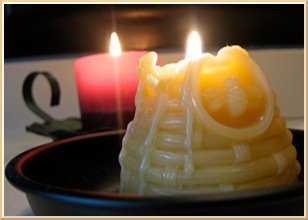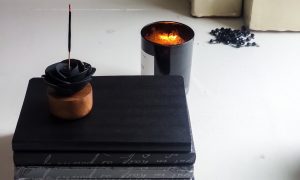Candles can be found everywhere in my house and I your house is probably full of them too. They offer us light, fragrance and comfort. We love them, but what we may not know is that candles can also hurt us.
Most candles are made of paraffin. This is a byproduct of petroleum, like almost everything else in our modern lives. Burning paraffin produces toxic smoke and soot that can be very dangerous for health, just like inhaling exhaust fumes from your car. (If you read about paraffin, go a little further and research the liquid paraffin, also called “mineral oil”, which we are sometimes recommended to slather with on our newborns’ skin.)
The Environmental Protection Agency (EPA) has done a number of studies regarding the use of candles and incense related to indoor air pollution. Soot produced by certain candles, the EPA articles show, can reach levels which are a health risk, as soot is inhaled deeply into the lungs from where it cannot be easily released. According to EPA, “soot is a product of incomplete combustion of carbon-containing fuels, usually petroleum based.”
The fragrance, that we buy most candles for, can increase the level of toxins, as they are mostly synthetic, product of the same petroleum. Also, apparently the fragrance softens the wax, causing it to not burn completely, as shown in this article from Care2. Candles sold in glass containers are less safe also, because they are deprived of the entire supply of oxygen needed for a clean burn.
Another source of worry in candles is represented by the lead-core wicks. The lead becomes airborne when the candle is burned. The EPA states in one of their papers that burning candles with lead-core wicks can lead to a concentration of lead in indoor air above safe levels.
According to the same source:
“Candles with the following characteristics have the potential to produce excessive soot:
• Candle with long, untrimmed wicks exceeding 1/8 inch
• Candles poured into glass jars or ceramic containers
• Candles with soft wax
• Aromatic (scented) wax
• Thick wick, or one with a wire core that keeps the wick upright
• Soot deposits on the mouth of the jar
• High, erratic flame when burned
• Visible soot emitted from an erratic flame
• Located in an air draft created by a fan or air conditioner duct
• Pillar candle with signs of uneven burning or thick, erect wick
•Multiple wick candles with thick, erect wick.
Candles with the following characteristics produce minimal soot and no vaporized lead:
• Hard wax
• Thin, braided wick that curls over when burned
• Low aromatic properties
• Tapered and votive candles with thin wicks
• Low, even flame when burned.”
I would add to this is beeswax or vegetable-oil based candles, just because it makes more sense to me to use something that’s not derived from petroleum.
So again, I realize that I have to do more research, be more aware of every thing I use or bring into my home, into our lives. It is very frustrating to have to do browse the Internet for hours, researching every little thing, but it has one benefit: it makes me buy less, because most products are just not up to my new standards. I am not going to complain about that.




